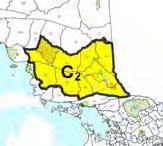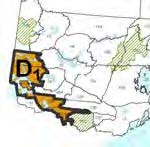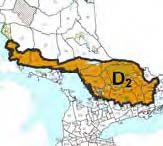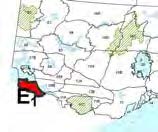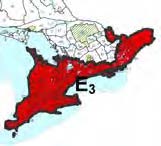Cervid ecological framework
The province has 4 wild cervid species: moose, white-tailed deer, woodland caribou and American elk. This document covers how the ministry manages and protects these species.
1.0 Introduction
Cervid is a term used to describe members of the deer family. Ontario has four wild cervid species: moose, white-tailed deer, woodland caribou and American Elk. Cervids are a highly valued and unique species group of Ontario’s wildlife heritage. They are considered by many as symbols of wilderness and are an important component of Ontario’s biodiversity.
The Ontario Ministry of Natural Resources (OMNR) is responsible for the protection and management of Ontario’s cervid species. The current strategic direction for wildlife is based on the documents Our Sustainable Future (OMNR 2005a) and Ontario’s Biodiversity Strategy (OMNR 2005b).
Cervid management is an ongoing priority for the ministry. Considerable new knowledge has been gained about population and habitat management, harvest assessment, restoration and recovery techniques, allocation models, inventory methods, and the resolution of human-cervid conflicts.
Cervid management deals with four different management programs (i.e., moose, white-tailed deer, woodland caribou, American elk). The moose and white-tailed deer management programs have a long history and are focused on maintaining population sustainability through population and habitat management. Both programs have been subject to a number of reviews, which has improved the understanding of the complexities of moose and deer management. The woodland caribou program focuses on population management and recovery through habitat management and minimizing stressors, while the elk program focuses on monitoring and management of restored populations.
The Cervid Ecological Framework provides new overarching policy advice to address cervid management at the broad landscape level. It consolidates and integrates Ontario’s approach to managing cervid species in relation to each other with consideration of the broader ecosystem(s) they share. This Framework is an important step in Ontario’s progress toward the management of cervids within an ecosystem context, and will guide opportunities to enhance cervid-specific management programs at the regional and provincial scale.
Statement of environmental values
The ministry, on behalf of Ontarians, is the steward of Ontario’s provincial parks, forests, fisheries, wildlife, mineral aggregates, and Crown lands and waters that make up 87% of the province. The ministry manages this responsibility through a diverse legislative mandate and an array of programs aimed at meeting the needs of the public. The ministry’s mission is to manage Ontario’s natural resources in an ecologically sustainable way to ensure that they are available for the enjoyment and use of future generations. The ministry is committed to the conservation of biodiversity and the use of natural resources in a sustainable manner.
In 2008 the ministry revised the Statement of Environmental Values (SEV) under the Environmental Bill of Rights (EBR). The SEV describes how the purposes of the EBR are to be considered whenever decisions that might significantly affect the environment are made by the ministry. The ministry has considered the SEV during the development of the Cervid Ecological Framework, which is intended to reflect its direction and to further the objectives of managing our natural resources on a sustainable basis. Specifically, it recognizes that cervid population and habitat management will contribute to the protection and conservation of biological, ecological and genetic diversity, as well as provide for the conservation and wise management of our natural resources, including plant life, animal life and ecological systems.
Ontario’s cervid species
A brief summary of each cervid species program is provided below as general context to the Cervid Ecological Framework. For more detailed information on a specific cervid management program, please refer to species-specific policy or background documents.
Moose (Alces alces)
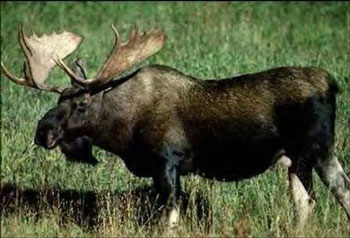
Moose management is focused on maintaining sustainable populations through population and habitat management. Ontario’s moose program is focused on ensuring sustainable moose populations and the ecosystems on which they rely, for the continuous provision of ecological, cultural, economic and social benefits for the people of Ontario.
Woodland Caribou (Rangifer tarandus caribou)

Ontario has two subspecies of Woodland Caribou: forest-dwelling ecotype and forest-tundra ecotype. Woodland Caribou (forest-dwelling ecotype) are listed as a ’threatened’ species at risk and protected under the Endangered Species Act, 2007. Management is focused on species and population recovery through landscape scale habitat management and minimization of stressors. The Caribou Conservation Plan forms the provincial policy for the conservation and recovery of caribou and their habitat.
American Elk (Cervus elaphus)

Elk management is shifting from population restoration to sustainable management in Ontario. The Cervid Ecological Framework forms the first step towards advancing elk management planning. Ontario’s elk program is focused on managing populations in suitable habitats and providing opportunities for recreation and tourism from elk, consistent with other land uses and for the continuous ecological, social, cultural and economic benefits for the people of Ontario.
White-tailed Deer (Odocoileus virginianus)
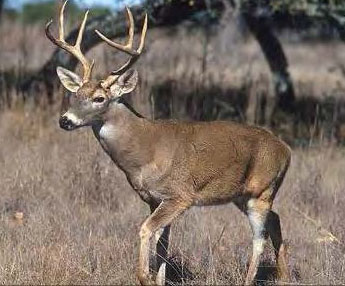
White-tailed Deer management is focused on maintaining sustainable populations through population and habitat management, while responding to social concerns (e.g., human-deer conflicts). Ontario’s white-tailed deer program is focused on ensuring sustainable white-tailed deer populations and the ecosystems on which they rely, for the continuous provision of ecological, cultural, economic and social benefits for the people of Ontario.
2.0 Scope
This document provides a framework for improving strategic decision-making about cervid management in Ontario. It acknowledges the challenges associated with managing wildlife across a diverse and complex landscape. These challenges include the need to integrate management approaches for multiple species and their habitats, as well as human activities and stressors such as disease and climate change. It provides an overarching provincial goal for cervid management, guiding principles and broad management guidance and considerations to enhance the management of cervids. It provides the strategic policy guidance for the integration of species-specific cervid policies/programs, and provides a landscape-level framework for future guidance. The framework strikes an appropriate balance between a provincially consistent approach while providing the flexibility to accommodate regional and local ecological differences and objectives.
The legal basis for the framework is provided by the Fish and Wildlife Conservation Act, 1997, the Endangered Species Act, 2007, the Crown Forest Sustainability Act, 1994, the Environmental Assessment Act, 1990, the Provincial Parks and Conservation Reserves Act, 2006, and the Planning Act, 1990 (through the Provincial Policy Statement).
The Cervid Ecological Framework supports Ontario’s biodiversity conservation goals to (1) protect the genetic, species and ecosystem diversity of Ontario and to (2) use and sustainably develop the biological assets of Ontario and capture benefits from such use for Ontarians (OMNR 2005b).
3.0 Cervid management goal
The goal of Ontario’s broader cervid management program is to ensure ecologically sustainable cervid populations and the ecosystems on which they rely, for the continuous ecological, cultural, economic and social benefits for the people of Ontario.
4.0 Guiding principles
The ministry's mission is to manage, on behalf of Ontarians, Ontario’s natural resources on the landscape in an ecologically sustainable way to ensure they continue to provide ecological, cultural, economic and social benefits to Ontarians and are available for the enjoyment and use of future generations. Guiding principles for the management of cervids are based on strategic directions in the ministry’s Our Sustainable Future and Ontario’s Biodiversity Strategy.
- Intrinsic value: All four cervid species have an intrinsic value within their ecosystems and to the people of Ontario.
- Adaptive management: An adaptive management approach will be applied to ensure that policy guidance is continually evaluated and improved based on new information. The Cervid Ecological Framework will be considered for review periodically to ensure guidance remains current and meaningful.
- Science and knowledge management: Cervid management will be supported by the best available scientific information (e.g., inventory, monitoring, research, and expert knowledge), community knowledge and Aboriginal traditional knowledge.
- Aboriginal treaty rights: Cervid management will respect Aboriginal peoples’ unique perspectives, traditional knowledge and practices related to Ontario’s cervids and the exercise of their constitutionally protected Aboriginal or treaty rights.
- Landscape and ecologically-based wildlife management: A landscape and ecologically-based approach to resource management is central to conserving biodiversity and using natural resources in a sustainable manner. Cervids will be managed within appropriate landscape scales in an ecosystem context (see 5.0 Cervid Ecological Zones). Consideration of predator-prey balance and their ecological relationships are an important factor in making management decisions.
- Risk based approach for species management: Where there are multiple species, cervid management decisions will consider species resilience, reproductive potential, conservation status and responsiveness to change in a risk based approach (e.g., the species with the highest risks may be given management priority over those of lower risk in a given area). The scale of application will be adjusted based on specific local management objectives.
- Enabling and flexible for local considerations: An enabling and flexible approach will continue to allow for local management decisions to address local circumstances and needs, while still contributing to the broader landscape-based cervid management approach. Wildlife Management Units (WMUs) continue to be the current basis for cervid allocation. Aggregations of WMUs may be appropriate for management and/or allocation decisions under some circumstances.
- Integrating management: Cervid management includes the management of both populations and habitat. Population and habitat management will be integrated through existing policies, land and resource management planning processes. It is recognized that management actions for one species may impact another species or habitat. Habitat management is an integral component of ecologically-based population management.
- Balance: Cervid management will integrate and balance the full range of ecological, social and economic factors within the context of ecological sustainability.
- Transparency: Cervid management approaches will be developed in collaboration with interested public, Aboriginal communities and stakeholders.
5.0 Cervid ecological zones
The following Cervid Ecological Zones (CEZs) have been developed to establish broad population and habitat management guidance. CEZs reflect the overarching cervid management intent at the landscape level. Ontario’s Ecological Land Classification system (Crins 2002, Crins et al. 2009) provides the foundation for the CEZs, with consideration of cervid species ranges and landscape level variations in habitat and climate. CEZs build on the existing Wildlife Management Unit network; while recognizing that species and habitat ranges fluctuate over time (see 7.4 Scales of Management). Broad management guidance will be applied across each CEZ to assist in setting local population and habitat objectives.
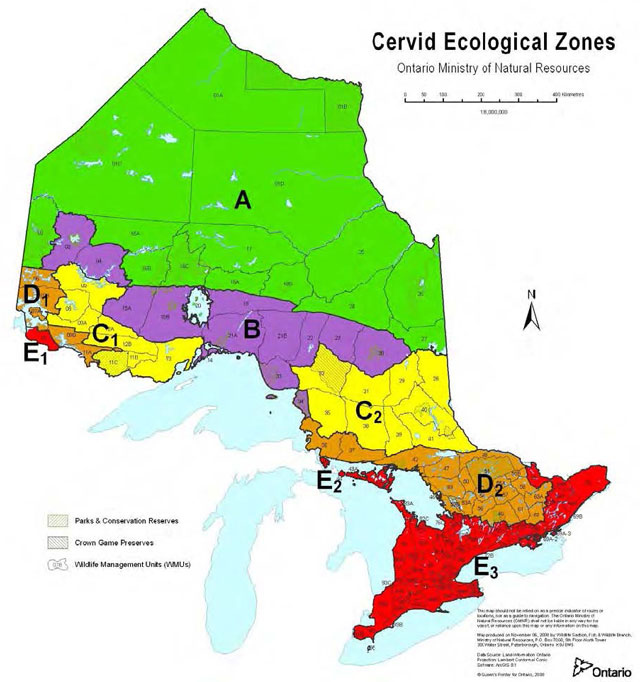
Enlarge Cervid ecological zones map
6.0 Broad cervid management guidance
The following broad cervid management guidance provides landscape-level, overarching population and habitat management guidance for each cervid species present within the Cervid Ecological Zones. Species-specific policy and program direction (contained in other policy documents) provides more detailed information on the application of this broad management guidance. This broad management guidance recognizes that multiple cervid species can and do exist on the same landscape in healthy and natural ecosystems.
| Cervid ecological zone | Broad management guidance population | Broad management guidance habitat |
|---|---|---|
A
| Woodland Caribou Moose – maintain low density population through provincial moose management program. White-tailed Deer | Addressed through land and resource planning processes
|
B
| Woodland Caribou Moose – maintain low to moderate density population (where appropriate as per species-specific policy direction) through provincial moose management program. White-tailed Deer – manage for low density population through provincial deer management program. | Addressed through land and resource planning processes
|
C1
| Moose – maintain moderate to high density population through provincial moose management program. White-tailed Deer – maintain low density population through provincial deer management program. Elk and Woodland Caribou | Addressed through land and resource planning processes
|
C2
| Moose – maintain moderate to high density population through provincial moose management program. White-tailed Deer – maintain low density population through provincial deer management program. Southern portions of the Zone may be maintained toward moderate density population. Elk – monitor the status by documenting reported sightings. Manage human-elk conflicts where necessary. Southern edge of Zone may be considered in CEZ D2 management (where appropriate). | Addressed through land and resource planning processes
|
D1
| Moose – maintain moderate density population through provincial moose management program. White-tailed Deer – maintain moderate density population through provincial deer management program. Elk – manage populations as directed by species-specific policy. Monitor population, range and document reported sightings. Manage human-elk conflicts where necessary. | Addressed through land and resource planning processes
|
D2
| Moose – maintain moderate to high density population through provincial moose management program. White-tailed Deer – maintain moderate density population within ecological carrying capacity (e.g., winter habitat) through provincial deer management program. Elk – manage populations as directed by species-specific policy. Monitor population, range and document reported sightings. Manage human-elk conflicts where necessary. | Addressed through land and resource planning processes
|
E1
| White-tailed Deer – maintain high density population through provincial deer management program. Elk – monitor population, range and document reported sightings. Manage human-elk conflicts where necessary. Moose – monitor status by documenting reported sightings. | Addressed through land and resource planning processes
|
E2
| White-tailed Deer – maintain moderate to high density population within socially acceptable limits and ecological carrying capacity (e.g., winter habitat) through provincial deer management program. In some areas, effects of high deer densities on biodiversity and species at risk habitats may need to be considered. Moose – maintain low density population in WMU 45 as part of local biodiversity. Local monitoring may be considered. | Addressed through land and resource planning processes
|
E3
| White-tailed Deer – maintain moderate to high density population within socially acceptable limits and ecological carrying capacity (e.g., winter habitat where appropriate) through provincial deer management program. In some areas, effects of high deer densities on biodiversity and species at risk habitats may need to be considered. Elk – monitor the status by documenting reported sightings. Manage human-elk conflicts where necessary. Moose – maintain low density population in WMU 65 through provincial moose management program. Monitor populations at the northern edge and eastern portion of the Zone (e.g., WMUs 63B, 75, 76). | Addressed through land and resource planning processes
|
Note about terminology and species densities:
The terminology used in 6.0 Broad Cervid Management Guidance is meant to broadly describe overarching policy guidance, while recognizing that exceptions may occur. Maintain refers to the intent to keep populations at a level consistent with ecological and social limits. The terms ’low’, ’moderate’ and ’high’ are used to describe broad population densities for moose and white-tailed deer. These terms are relative and can vary in meaning depending on perspective, geography, carrying capacity of the landscape, etc. As such, the following value ranges may be considered to better understand what these terms mean at the landscape-level. For Moose, Low = 0 – 20/100km2, Moderate = 20 – 40/100km2, High = 40 –60/100km2. For White-tailed Deer, Low = 0 – 200/100km2, Moderate = 200 – 500/100km2, High = 500 –1000/100km2. These broad value ranges apply at the Cervid Ecological Zone scale. They should not be used as WMU density targets, but may be used to assist objective-setting exercises.
7.0 Broad cervid management considerations
Application of the overarching strategic guidance in this Framework recognizes a broad range of spatial and temporal landscape level considerations. Landscape-level spatial and temporal trends (e.g., changes in climate, species ranges, functional habitat, land use, disease concerns, socio-economics) will influence cervid management over time. The broad cervid management guidance is flexible enough to accommodate and respond (where appropriate) to these changes. Over the long-term, an adaptive management approach (see section 4.0 Guiding Principles) will be applied to ensure that policy direction is continually evaluated and improved based on new information.
7.1 Landscape and ecologically-based wildlife management
Landscape and ecologically-based wildlife management is a landscape planning approach that maintains biodiversity and ecosystem integrity while integrating social and economic considerations. Sustaining ecosystem function and integrity is the basis for continuing to provide a range of uses of the resource. Cervids will be managed within this landscape and ecologically-based context; recognizing that management actions for one species may impact another species or habitat (e.g., habitat supply, food availability, predation, disease, competition). Cervid management objectives will be harmonized with other elements of biodiversity, including other wildlife species and habitat management direction to achieve a desired landscape and ecologically-based outcome.
7.2 Social, cultural and economic benefits
Cervid populations provide a broad range of economic, social and cultural benefits to Ontario residents. These include both direct benefits (e.g., hunting, viewing, tourism) and indirect benefits (e.g., contributions to biodiversity, bequest to following generations). It is also important to recognize that detriments may arise in some cases (e.g., human-wildlife conflicts). The considerable knowledge and views of all Ontarian’s regarding the role of cervids in ecosystems and the appropriate ways to manage them contribute to sustainable management decision-making.
The guidance within this Framework integrates ecological, social, cultural and economic factors, within the larger context of ecological sustainability in both modified and natural environments.
7.3 Species-specific policy and program direction
Moose, elk, woodland caribou and white-tailed deer have their own unique and established policy and program direction. The Cervid Ecological Framework works to enhance management by integrating and collectively considering management direction at the landscape level. It provides the policy framework for the points of intersection amongst the cervid programs. It is also forward-looking in that it both directs and accommodates future updates to species-specific cervid policies and programs.
7.4 Scales of management
The scales of management and recognition of existing management and allocation processes that are relevant to cervids are important considerations within the context of the Cervid Ecological Framework. A multi-scale approach is used to help inform population and habitat management for cervids across the province. The figure below illustrates an example of the hierarchy of nested management scales associated with population and habitat management in provincial cervid programs.
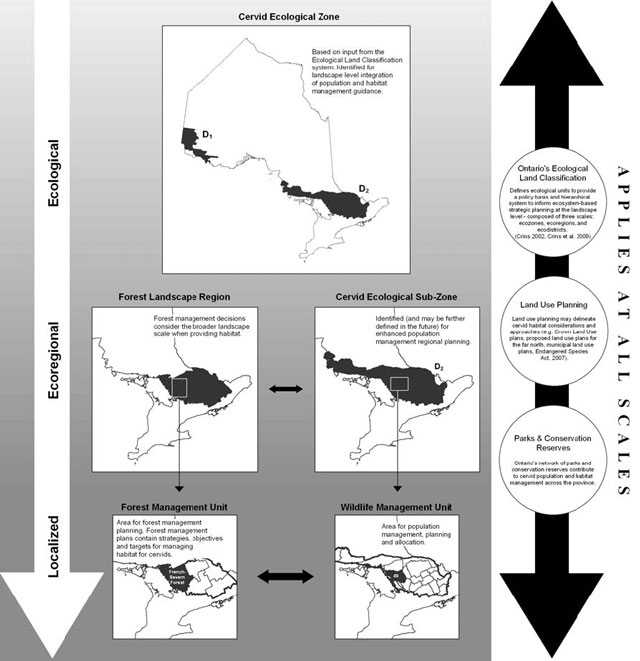
Enlarge Cervid ecological framework diagram
It is recognized that other existing boundaries may be more appropriately used for habitat management in some cases (e.g., caribou ranges, landscape guide regions, forest management units) because Cervid Ecological Zones utilize Wildlife Management Units, which are primarily designed for population management. However, habitat management guidance provided in this framework should be considered in any relevant land or resource planning process and applied at the appropriate scale.
Cervid Ecological Zones and associated management direction may adjust over time with expanding or contracting species and habitat ranges (particularly along the edges of species range). As such, there is some inherent flexibility built into the Cervid Ecological Zones and adjustments may be considered over time. It is important to recognize the inherent variation in these management processes and their relationship to scales of management on the landscape.
7.5 Population management
The provincial policies/programs for Ontario’s four cervid species are inherently different owing to ecological differences in species biology, range, habitat needs, etc. As such, each species has its own unique program and management objectives. As a result, there are some challenges with harmonizing individual program objectives into compatible management guidance for all cervids and other elements of biodiversity within each CEZ or sub-zone. This harmonization is achieved through a broad scale, objective-based approach for individual cervid species, while considering other elements of biodiversity on the same landscape.
Cervid population management objectives will be harmonized with other wildlife species according to existing policy and program direction to achieve a desired ecosystem-based outcome (e.g., Strategy for Wolf Conservation in Ontario (OMNR 2005c), Framework for Enhanced Black Bear Management in Ontario (OMNR 2008a), Ontario’s Biodiversity Strategy (OMNR 2005b)). Predator-prey interactions and the role they play within the ecosystem context are important considerations for cervid population management. Landscape-level population management objectives will consider ecological, social and economic objectives, including the overall ecosystem health as a whole.
7.6 Habitat management
The Cervid Ecological Framework harmonizes and integrates habitat and population management priorities to provide overarching guidance. It reflects a broad scale landscape-based approach, which allows for the quality of habitat necessary to ensure cervid populations are sustainable. It also recognizes the primary mechanisms for addressing cervid habitat needs on Crown and private/municipal lands.
On Crown lands within the Area of the Undertaking, habitat management in forested ecosystems is primarily conducted through the forest management planning process (i.e., preparation of forest management plans and use of forest management guides). The ministry is moving towards a coarse and fine filter approach for forest management at landscape and stand and site scales (OMNR 2008b, OMNR 2008c, OMNR 2008d). Generally, outcomes of coarse filter habitat direction should support natural cervid densities and outcomes of the fine filter habitat direction should further enhance cervid habitat suitability. The forest management planning process will be the primary mechanism for addressing cervid habitat management on Crown lands within the Area of the Undertaking.
Habitat management guidance within this Framework replaces previous policy direction for cervids as outlined in Policy 6.04.01 Management of Timber for Featured Wildlife Species (OMNR 1990). Management guidance within this Framework (6.0 Broad Cervid Management Guidance) may be used to inform the application or emphasize species-specific cervid habitat direction (e.g., moose) contained in forest management guides.
On public lands within the Far North (i.e., generally the area to the north of the Area of the Undertaking, Woodland Caribou Provincial Park and Wabakimi Provincial Park), First Nation Community Based Land Use Plans will determine what areas are available for sustainable economic development and what areas will be protected. These plans will be supported by land use planning objectives that recognize environmental, social and economic interests and a Far North Land Use Planning Strategy, both of which would consider ecological systems, processes and functions, as well as biodiversity.
On private and municipal lands, the ministry recommends habitat management objectives similar to those used on Crown lands through the appropriate land use planning processes. The Natural Heritage Reference Manual (OMNR 1999) and the Significant Wildlife Habitat Technical Guide (OMNR 2000) are the primary mechanisms for addressing cervid habitat needs and considerations on private and municipal lands under the authority of the Planning Act, 1990 and the Provincial Policy Statement (OMMAH 2005). Local stewardship projects (e.g., Community Fish and Wildlife Involvement Program, Species at Risk) and private land forestry practices involving cervid habitat need to be consistent with the overarching habitat management guidance within this Framework.
Ontario’s network of provincial parks and conservation reserves currently represent approximately 9% of the provincial land base and are a significant contributor to cervid habitat. Any habitat management within provincial parks and conservation reserves are governed by management direction for the specific protected area and the principles of the Provincial Parks and Conservation Reserves Act, 2006.
7.7 Climate change
Climate change will pose increasing challenges to the earth’s natural ecosystems. Cervid populations may be affected by climate change due to changing temperatures and altered precipitation patterns. The effects of climate change may vary by species and location. Cervid species range expansions/contractions may require adaptive management, as outlined in the Guiding Principles of this Framework. Adapting to these changes will require public awareness and understanding as well as collaboration among government and non-government groups.
Ontario’s “Go Green” Action Plan on Climate Change (Government of Ontario 2007) provides a plan for the Government of Ontario to work with the public, stakeholders, and partners to better understand the effects of climate change, implement mitigation techniques, and assist Ontarians in adapting to changes. MNR’s strategy and action plan, Sustainability in a Changing Climate (2009) represents a ministry-wide commitment to address climate change priorities within the broader context of the Ontario government plan. Species-specific policy and program direction will identify information needs and strategies to address cervid-specific needs related to climate change.
7.8 Disease
The rapid pace of disease emergence around the world has created new challenges for wildlife management. Chronic Wasting Disease, brainworm, epizootic hemorrhagic disease, and bovine tuberculosis are some of the diseases that threaten Ontario’s cervid populations. Canada’s National Wildlife Disease Strategy (Government of Canada 2004) articulates federal and provincial government commitments to address these issues. Ontario’s Chronic Wasting Disease Surveillance and Response Plan (OMNR 2005d) outlines key actions to minimize threats to wild and farmed cervid populations.
Ontario will continue to monitor and research wildlife diseases, implement prevention measures, communicate with the public and stakeholders (e.g., agricultural community) and respond to significant disease threats as they arise.
7.9 Human-cervid conflicts
Human-wildlife conflict results when the actions of humans or wildlife have an adverse impact upon the other. With changing land use patterns, there is increasingly more overlap between human and cervid habitat, which is creating more potential for conflict (particularly white-tailed deer and elk in some agricultural and urban areas, and moose and deer on some roadways).
The Government of Ontario released the Strategy for Preventing and Managing Human-Wildlife Conflict in Ontario (Government of Ontario 2008a) and Strategy for Preventing and Managing Human-Deer Conflict in Southern Ontario (Government of Ontario 2008b). These strategies outline approaches to address human-cervid conflicts, including a focus on community and partnership-based actions, leadership and responsibility, and public understanding. Ontario will continue to work with partners and stakeholders to address these needs.
7.10 Science and knowledge management
Managing multiple cervid species requires an understanding of the population distribution and trends relative to the ecological carrying capacity and relationships with other species. It requires an understanding and assessment of social and economic values in order to consider and develop and achieve appropriate management objectives. Use of the most current and best available information, as well as continuing to research, inventory and monitor wildlife populations is critical for informed decision-making, policy development/evaluation and implementing an adaptive management approach. Research, inventory, monitoring and assessment should generally focus on cervid populations’ range and status trends, addressing key knowledge gaps and risk assessment (e.g., climate change, disease transmission), evaluating cervid species interactions and the effects of specific management actions (e.g., effectiveness monitoring program associated with forest management). Objectives and strategies for research and monitoring can be found in the species-specific policy and program direction for Ontario’s cervids.
Local knowledge from hunters, farmers, trappers and others living close to the land are important considerations for decision making.
Aboriginal communities have accumulated knowledge about wildlife and the natural environment that has been passed down from generation to generation. This Aboriginal traditional knowledge is a knowledge-practice-belief system that is expressive of the cultural diversity of Aboriginal communities and their descriptive observations of wildlife populations and habitats as they are used. Aboriginal traditional knowledge along with western science knowledge will contribute to more informed decision making.
8.0 Implementation
The implementation of the Cervid Ecological Framework together with species-specific policy and program guidance are intended to help inform decision making related to the management and allocation of Ontario’s cervid species. The Cervid Ecological Framework will be reviewed periodically as needed.
9.0 References
Crins, W. J. 2002. The Ecozones, Ecoregions, and Ecodistricts of Ontario. [map] Prepared for the Ecological Land Classification Working Group. Ontario Ministry of Natural Resources, Peterborough, Ontario.
Crins, W. J., P. A. Gray, P. W. C. Uhlig, and M. C. Wester. 2009. The Ecosystems of Ontario, Part 1: Ecozones and Ecoregions. Ontario Ministry of Natural Resources, Sault Ste. Marie, Ontario.
Government of Canada. 2004. Canada’s National Wildlife Disease Strategy. Ottawa, Ontario. 23 p. Online: http://www.cws-scf.ec.gc.ca/cnwds/index_e.cfm [link inactive]
Government of Ontario. 2007. Ontario’s “Go Green” Action Plan on Climate Change. Toronto, Ontario. 45 p. Online.
Government of Ontario. 2008a. Strategy for Preventing and Managing Human-Wildlife Conflict in Ontario. Peterborough, Ontario. 12 p. Online.
Government of Ontario. 2008b. Strategy for Preventing and Managing Human-Deer Conflict in Southern Ontario. Peterborough, Ontario. 20 p. Online.
Ontario Ministry of Municipal Affairs and Housing (OMMAH). 2005. Provincial Policy Statement. Toronto, Ontario. 37 p. Online.
Ontario Ministry of Natural Resources (OMNR). 1990. Policy 6.04.01 Management of Timber for Featured Wildlife Species. Wildlife Branch. 4 p.
Ontario Ministry of Natural Resources (OMNR). 1999. Natural Heritage Reference Manual – For Policy 2.3 of the Provincial Policy Statement. Peterborough, Ontario. 128 p. Online.
Ontario Ministry of Natural Resources (OMNR). 2000. Significant Wildlife Habitat Technical Guide. Peterborough, Ontario. 139 p. Online.
Ontario Ministry of Natural Resources (OMNR). 2005a. Our Sustainable Future. Queen’s Printer of Ontario. 23 p. Online: http://www.mnr.gov.on.ca/MNR_E000002.pdf [link inactive]
Ontario Ministry of Natural Resources (OMNR). 2005b. Protecting What Sustains Us – Ontario’s Biodiversity Strategy. Queen’s Printer of Ontario. 44 p. Online: http://www.mnr.gov.on.ca/MNR_E000066.pdf [link inactive]
Ontario Ministry of Natural Resources (OMNR). 2005c. Strategy for Wolf Conservation in Ontario. Peterborough, Ontario. 8 p. Online.
Ontario Ministry of Natural Resources (OMNR). 2005d. Ontario Chronic Wasting Disease Surveillance and Response Plan. Peterborough, Ontario. 42 p. Online.
Ontario Ministry of Natural Resources (OMNR). 2008a. Framework for Enhanced Black Bear Management in Ontario. Peterborough, Ontario. 11 p. Online.
Ontario Ministry of Natural Resources (OMNR). 2008b. Forest Management Guide for Great Lakes-St. Lawrence Forest Landscapes. Draft – for EBR registry posting – November 2008. Thunder Bay, Ontario. 63 p. Online.
Ontario Ministry of Natural Resources (OMNR). 2008c. Forest Management Guide for Boreal Forest Landscapes. Under development. Thunder Bay, Ontario.
Ontario Ministry of Natural Resources (OMNR). 2008d. Forest Management Guide for Conserving Biodiversity at the Stand and Site Scales. Draft – for EBR registry posting – November 27, 2008. Sault Ste. Marie, Ontario. 150 p. Online.
Footnotes
- footnote[*] Back to paragraph Woodland Caribou (forest-dwelling ecotype) are listed as a ’threatened’ Species at Risk and protected under the Endangered Species Act, 2007. The Caribou Conservation Plan forms the provincial policy for the conservation and recovery of woodland caribou and their habitat.
- footnote[**] Back to paragraph White-tailed Deer are not a common cervid species in Cervid Ecological Zone A. They have been included in the broad management guidance for this area because their range is known to expand and contract (particularly along the edges of range) over time with changing environmental factors (e.g., climate change, winter weather severity).
- footnote[***] Back to paragraph Land and resource planning processes result in decisions on land and resource management that may affect cervid management. Examples of relevant land use plans include existing Crown land use plans, proposed land use plans for the Far North, and municipal land use plans. Relevant resource plans include Forest Management Plans, plans for protected areas and private land or agency stewardship initiatives.



